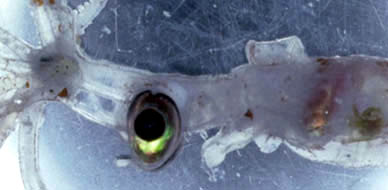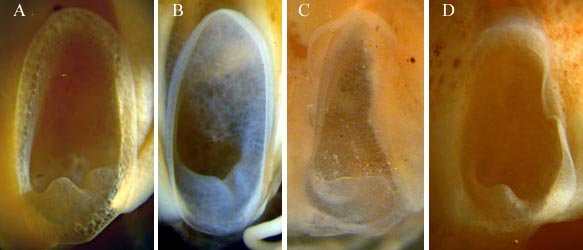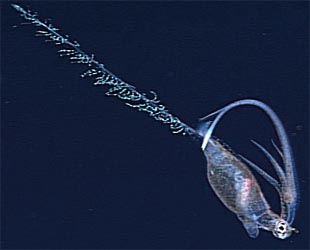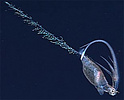Planctoteuthis
Richard E. Young, Michael Vecchione, and Clyde F. E. Roper- Planctoteuthis danae (Joubin 1931)
- Planctoteuthis exopthalmica (Chun 1910)
- Planctoteuthis levimana (Lonnberg 1896)
- Planctoteuthis lippula (Chun 1908)
- Planctoteuthis oligobessa Young 1972
Introduction
Species of Planctoteuthis are usually rather small and very fragile deep-sea squids that are often badly damaged during capture. As a result, few species have been described. Unlike other chiroteuthids, the subadult retains the peculiar doratopsid paralarval tentacular club. Roper and Young (1967) suggest that Planktoteuthis is a neotenic doratopsis.
Diagnosis
A chiroteuthid ...
- with antitragus only in oval funnel locking-apparatus.
- with a compact club not divided into proximal and distal regions by structure of protective membranes.
- without funnel valve.
- without photophores.
Characteristics
- Arms
- Subequal in length in adults; arms IV much the longest in young.
- Arms IV with relatively few suckers usually aligned in virtually single series.
- Tentacles
- Club small, compact.
- Low protective membranes along both boarders.
- Not divided into proximal and distal regions by protective membranes.
image info
Figure. Oral view of tentacular club of Planctoteuthis lippula, Hawaiian waters, 35 mm ML. Photograph by R. Young.
- Head
- Head with elongate neck and brachial pillar.
- Eyes commonly project ventrally from head.
 image info
image info Figure. Lateral view of head of Planctoteuthis lippula, Hawaiian waters, 35 mm ML. Photograph by R. Young.
- Funnel
- Funnel valve absent.
- Funnel locking apparatus oval with posterior bump (antitragus) (see Comments).
 image info
image info Figure. Ventral view of funnel locking-apparatus of P. danae, off California, 47 mm ML, showing posterior antitragus and no medial tragus. Drawing from Young (1972).
- Photophores
- Absent.
- Tail
- Tail present (usually lost during capture) with appendages. Appendages undescribed.
Comments
The exact form of the antitragus in the funnel locking-apparatus is often a species-specific feature. Unfortunately this structure is difficult to see and lighting and angle of view can often give different apparent results. The character must be used cautiously. Compare the locking apparatuses of the following species:
 image info
image info Figure. Funnel component of the funnel/mantle locking apparatus of various species of Planctoteuthis. A - P. danae. B - P. levimana, 60 mm ML. C - P. lippula, 55 mm ML. D - P. oligobessa. Photographs by R. Young.
The species are compared in the following table.
| Arm IV suckers, number | Arm sucker dentition, arm I-III | Antitragus | Fin length | Club shape | Club keel | Distribution | |
| P. danae | 12-13 | 7-9 distal truncated teeth | Double. Lobes nearly equal | 52% ML | Symmetrical | No | Trop. Pacific |
| P. exopthalmica = P. levimana? | 10 | ? | ? | width=36% ML | Symmetrical | No | S. Indian |
| P. levimana | 6-8 | Broad truncate teeth all around | Double. Lobes unequal | 40% ML | Long, symmetrical | No | N. Atlantic, Trop. Pacific |
| P. lippula | 25 | >50 minute teeth, distal larger | Single or slight double. Low, broad | 40-45% ML | Short, Asymmetrical | Yes | Atlantic, Trop. Pacific |
| P. oligobessa | 2-4 | 25-35 blunt teeth, distal 2/3 | Single. Slender | 23-33% ML | Symmetrical | No | Trop. Pacific |
Nomenclature
The type species, Planctoteuthis danae, was originally placed in a new genus, Valbyteuthis, within a new family, Valbyteuthidae, by Joubin (1931). Roper and Young (1967) placed Valbyteuthis in the family Chiroteuthidae noting the similarity of Valbyteuthis paralarvae to those of Chiroteuthis. Young (1991) recognized that some paralarvae of Valbyteuthis had been previously descibed by Pfeffer (1912) as members of his new genus, Planctoteuthis, within the Chiroteuthidae. Valbyteuthis, therefore is a junior synonym of Planctoteuthis.
Life History
The doratopsis paralarva of Planctoteuthis can be recognized by:
- Strong ventral projection of eyes.
- Few suckers on arms, tentacles (young doratopsis).
- Relatively small, tapering tentacles (young doratopsis).
- Reduced vesicular region on mantle (young doratopsis).
Distribution
Lower mesopelagic to bathypelagic depth distribution within tropical to temperate oceans of the world.References
Joubin, L. 1931. Notes preliminaires sur les Cephalopodes des croiseires du "Dana" (1921-1922). Annales de l'Institut Oceanographique, 10: 169-211.
Pfeffer, G. 1912. Die Cephalopoden der Plankton-Expedition. Ergebniss der Plankton-Expedition der Humboldt-Stiftung. 2: 1-815.
Roper, C. F. E. and R. E. Young. 1967. A review of the Valbyteuthidae and an evaluation of its relationship with the Chiroteuthidae. Proc. U.S. Nat. Mus. 123: 1-9.
Young, R. E. 1972. The systematics and areal distribution of pelagic cephalopods from the seas off Southern California. Smithson. Contr. Zool., 97: 1-159.
Young, R. E. 1991. Chiroteuthid and related paralarvae from Hawaiian waters. Bull. Mar. Sci. 49: 162-185.
Title Illustrations
| Scientific Name | Planctoteuthis oligobessa |
|---|---|
| Location | 32? 52.29 N, 131? 17.49 W, North Pacific off California |
| Specimen Condition | Live Specimen |
| Copyright | © Monterey Bay Aquarium Research Institute |
About This Page
Richard E. Young
Dept of Oceanography
University of Hawaii
Honolulu, Hawaii 96822
USA
National Marine Fisheries Service
Systematics Laboratory
National Museum of Natural History
Washington, D. C. 20560
USA
Page copyright © 1999 Richard E. Young, , and
Citing this page:
Young, Richard E., Vecchione, Michael, and Roper, Clyde F. E. 1999. Planctoteuthis . Version 01 January 1999 (under construction). http://tolweb.org/Planctoteuthis/19464/1999.01.01 in The Tree of Life Web Project, http://tolweb.org/








